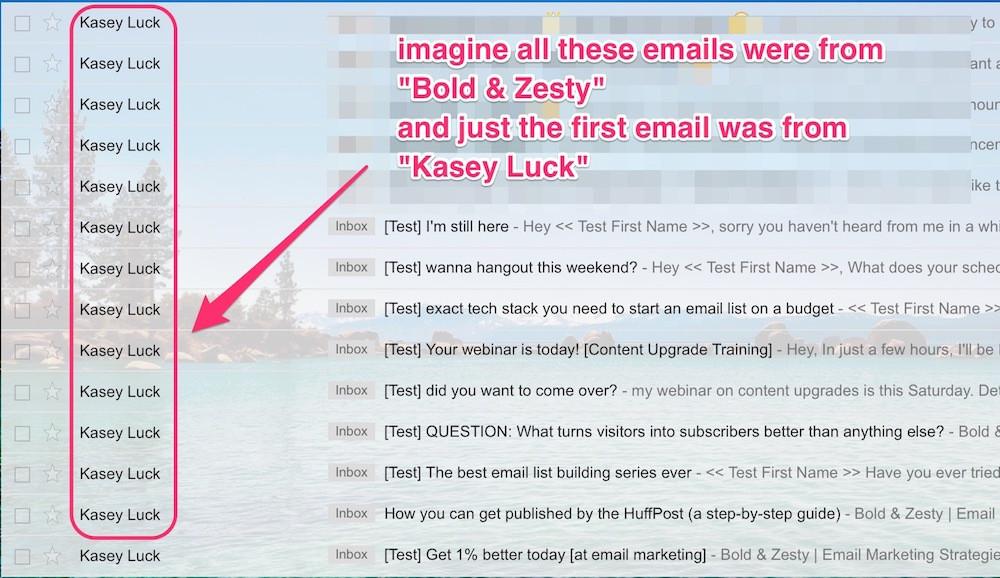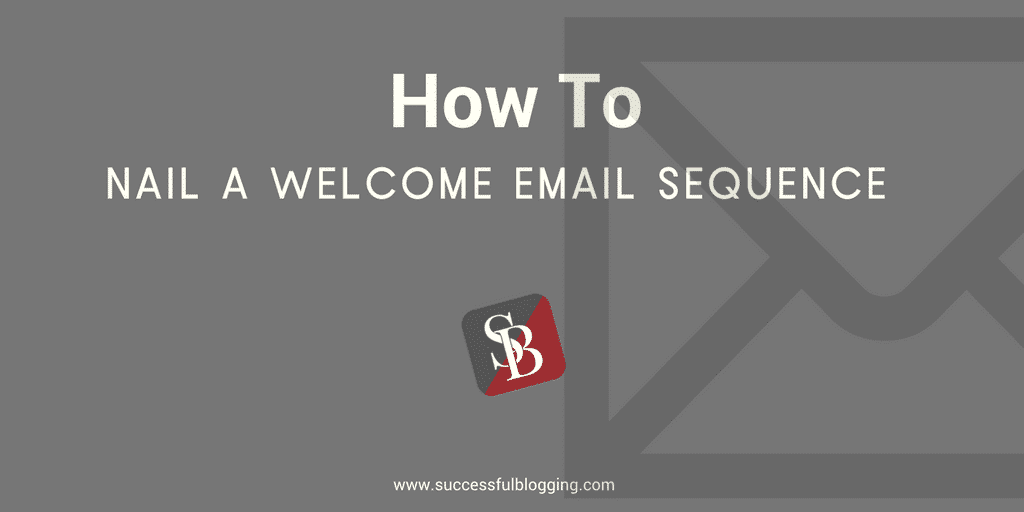I think you’ll agree with me when I say:
First impression matters a great deal.
That applies to new subscribers on your email list, too.
When someone new joins your email list, you have a unique chance to build trust with them, show the value of staying in your community, and lead them towards a valuable (for you and for them) action.
You can achieve all of that with having the best welcome emails in a sequence (also known as a drip campaign — I’ll use those two terms interchangeably).
When you get your welcome email series right, you turn a cold lead into a loyal fan, and, sometimes, even a customer — within a matter of two weeks.
And in today’s post, I’m going to show you what makes a welcome email sequence GREAT at achieving those goals … and how you can do it easily for your email list.
Let’s begin.
Oh, and I also included a sweet bonus at the end of the post with an email-by-email structure for three different email drip campaigns EVERY blogger must have, including a welcome email template.
Download, plug and ship.
The Goal Of The Best Welcome Emails
The moment someone subscribes to your list is the best time to build a relationship with them because that’s when they are in the “high intent” mode: they voluntarily decided to join your list because they saw some benefit in it.
Use this timing to your advantage and build up momentum in your relationship with the subscriber.
How?
Make them feel even better about joining your list by showing that they are in the right place, giving them super valuable content for free, and asking questions to get a conversation going.
Effective welcome emails are strategic, and they must attempt to accomplish 3 key things:
- Create a connection
- Build trust
- Tease
I’ll show you exactly how to do each of these in a minute, but before we get to that, let’s take a look at the very first email you send to new subscribers.
It’s vital that you do 4 things right.
Do These 4 Things Right In Your First Welcome Email

The first onboarding welcome email you send to your subscribers will have the highest open rate among all of your emails, so it’s a prime opportunity to do the following things:
Introduce your sender persona
Tell them who you are and why you’ll be emailing them.
Why should they listen to you?
Why should they care?
Make sure the first email uses the same “from name” and “from email address” as all later ones (otherwise, what’s the point of welcoming them in and then confusing by introducing other sender names).
Set expectations for when and how often you’ll be in touch
In your first welcome email, give your subscribers an idea of how often you’ll email them, so they know what to expect.
People like to be warned and prepared; it creates a feeling of trust and familiarity.
Ask subscribers to add you as a safe sender.
This is an important step that will make a HUGE difference in improving your deliverability down the road.
One of the most desirable things for marketers is to get in the “Primary” tab in Gmail, and the most effective strategy for that is asking subscribers to put you there.
Show your subscribers how they can drag and drop your message to the “Primary” tab in Gmail, and remind them to confirm that they want all emails from you to land there.
Another strategy to help with the deliverability of your emails is to ask your subscribers to reply to your email.
Once they reply, their email client adds your email address to the “important” list in their inbox.
And who doesn’t want to be important? 🙂
Of course, for both of these strategies, you’ll want to give your subscribers good enough reasons to take these actions.
Show them you’re worth it by going above & beyond in providing value and useful resources, and building a personal connection.
Ask to help you with segmentation
If you want to segment your list based on subscriber interests or demographics, the first welcome email is the perfect place to ask them to show their preferences.
Ask your reader what they’d be most interested in hearing about, and provide a few links that trigger a field label change in your database.
For example, if your list is for art-lovers, ask them to select their preferences, so you know what content and offers to send them. It would look something like this:
“Please select the arts you love most, so I only send you the most relevant info:
- performance arts
- fine arts
- alternative arts ”
Or, if you’d like to keep it simple, do what Jeremy Cowart did in his welcome email:
Make sure you explain that you need this info to serve them better.
Make it about them, not you (this applies to everything you do, by the way).
Only ONE call to action per email
I’m giving you many ideas for optimizing your first welcome email, but keep in mind that you should only ask your subscribers to do ONE thing per email.
The more choices we have, the more confused, or at least unmotivated, we become to actually do anything at all. It’s called decision fatigue.
If you want to keep your email click-through rate high, limit the number of calls to action in each email to just one.
Don’t ask for too much.
Your Welcome Drip Campaign
Now that we’ve got the first email out-of-the-way, let’s focus on the rest of the sequence.
An ideal welcome drip campaign is usually between 3 and 5 emails, spaced 1-3 days apart.
Depending on your business and your offering, you can take that drip campaign in many directions, but no matter what you’re selling, you’ll want to accomplish the following goals.
#1. Create a connection
One of the most important goals of an email sequence is to create a connection between you and the subscriber.
You can do that by making them feel special:
- Take an interest in what they do and what they’re looking to get out of your community (ask them!)
- Provide valuable insights and behind-the-scenes information others withhold.
- Show that you’re like them by highlighting what you have in common.
People like people who are like them. In your second or third email, share a personal story that would resonate with your target subscriber.
By finding the commonalities, your subscribers will want to read more of what you writ, so they can find even more things in common.
We all feel safer when we know there are other people who are just like us and share our goals, fears, passions, interests, and struggles.
#2. Build trust
Another important thing you want to get your subscribers to do is to trust you and associate you with THE source of information when it comes to your topic.
How do you do that?
- Send them content that’s 10X more valuable than anything else shared online.
- Don’t be afraid to get on camera and record a video – you’re evoking so many more emotions and become much more memorable by adding visual and auditory senses to text.
- Provide social proof in the form of customer testimonials, results you’ve driven for your clients, the number of people you helped in this industry, and other accomplishments that are relevant to your topic.
#3. Tease
Finally, as you near the end of your welcome sequence, start teasing subscribers with the offer you prepared for them.
This could be your main product or service, or a smaller paid product that’s a qualifier for your “signature” offering.
Announce you’ll be offering something in the near future, and be clear about timing – urgency and expectation are powerful forces in marketing.
Use subject lines that evoke curiosity, and make it easy for yourself to transition into the sales sequence.
Welcome Email Drip Campaign — Sample Structure
To help you put everything you just learned into practice, here’s a sample template for a “welcome” email drip campaign.
Use this structure and make it yours by offering your unique benefits and adding your voice to the dry “principles” and “tactics”.
Email #1: Thanks for subscribing!
Thanks for subscribing, here’s what to expect from this list (focus on the benefits you will provide for them, not just what you’ll write about); links to the best content.
Email #2: Your best content
Describe ways in which they can use free content and tools on your website for their business OR send one piece of your best content in the email format.
Email #3: Nurture & engage
More nurturing content OR an invitation to a webinar OR ask them a question so you can understand your audience and segment it better.
Want to have this email structure handy so you can refer to it as you write your email drip campaigns?
You can also structure your welcome drip campaign to be a mini-course that teaches a topic that is highly relevant to what you sell.
You can deliver all content directly in your emails, or drive subscribers to your landing pages.
Mastering Your Welcome Email Sequence
Congratulations! You are well on your way to becoming a master of the welcome email sequence.
You’ve learned that the most important thing is to build a personal connection with your readers and get them to trust you.
I’ve shared multiples strategies that help with that, including sharing personal stories, highlighting things in common, and showcasing social proof, among others.
You’ve also learned important technical things you’ll want to do to keep your deliverability and click rates high.
Finally, you’ve also got a sample structure to follow to write your first welcome sequence — or improve an existing one.
Now, go implement what you’ve learned!
There won’t be a better time to use all of this momentum.
And if you’re anything like me, you won’t want to stop at just the welcome sequence.
There are other must-have drip campaigns for any blogger, which I summarized and templated for you in the next section.
Download 3 Email Drip Campaign Templates
I have prepared a special bonus for you.
You know a welcome sequence is a must if you want to maximize the value of your email list, but there is so much more that you can do!
There are 3 drip campaigns any blogger must have:
- Welcome sequence
- Nurturing Sequence
- Sales sequence
I summarized and prepared a template for each of those sequences and packaged all of them into a compact PDF, which you can download – completely free – below.






